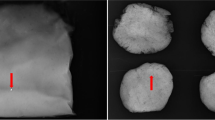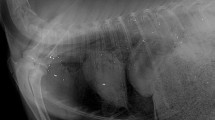Abstract
Recently, the use of lead isotope ratios has definitively identified lead ammunition as a source of lead exposure for First Nations people, but the isotope ratios for lead pellets and bullets were indistinguishable. Thus, lead-contaminated meat from game harvested with lead bullets may also be contributing to the lead body burden; however, few studies have determined if lead bullet fragments are present in big game carcasses. We found elevated tissue-lead concentrations (up to 5,726.0 μg/g ww) in liver (5/9) and muscle (6/7) samples of big game harvested with lead bullets and radiographic evidence of lead fragments. Thus, we would advise that the tissue surrounding the wound channel be removed and discarded, as this tissue may be contaminated by lead bullet fragments.

Similar content being viewed by others
References
ATSDR (2005) Toxicological profile for lead (draft) US department of health and human services, agency for toxic substances and disease registry, US. http://www.atsdr.cdc.gov/toxprofiles/tp2.html. Accessed February 27, 2007
California Department of Fish and Game (2008) Attention hunters: “it’s time to get the lead out”. http://www.dfg.ca.gov/wildlife/hunting/condor/. Accessed December 8, 2008
Church ME, Gwiazda R, Risebrough RW, Sorenson K, Chamberlain CP, Farry S, Heinreich W, Rideout BA, Smith DR (2006) Ammunition is the principal source of lead accumulated by California condors re-introduced to the wild. Environ Sci Tech 40:6143–6150
Fackler ML, Surinchak JS, Malinowski JA, Bowen RE (1984) Bullet fragmentation: a major cause of tissue disruption. J Trauma 24:35–39
Falandysz J, Szymczyk-Kobrzynska K, Brzostowski A, Zalewski K, Zasadowski A (2005) Concentrations of heavy metals in the tissues of red deer (Cervus elaphus) from the region of Warmia and Mazuruy, Poland. Food Add Contam 22:141–149. doi:10.1080/02652030500047273
Frank A (1986) Lead fragments in tissues from wild birds: a cause for misleading analytical results. Sci Total Environ 54:275–281. doi:10.1016/0048-9697(86)90272-X
Gustavsson P, Gerhardson L (2005) Intoxication from an accidently ingested lead shot retained in the gastro-intestinal tract. Environ Health Perspect 113:491–493
Health Canada Food and drug regulations (1991) Food and drug regulations. Table 1: division 15 (Revised 14 February 1991). Health Canada, Ottawa
Hubbard AW, Pocklington WD, Wood EC (1965) The lead content of game. J Assoc Public Analy 3:29–32
Hunt WG, Burnham W, Paris CN, Burnham KK, Mutch B, Oaks JL (2006) Bullet fragments in deer remains: implications for lead exposure in avian scavengers. Wild Soc Bull 34:167–170. doi:10.2193/0091-7648(2006)34[167:BFIDRI]2.0.CO;2
Kramer JL, Redig PT (1998) Sixteen years of lead poisoning in eagles, 1980–1995: an epizooiologic view In: Money S (ed) Hunting with lead shot–wildlife and human health concerns. Canadian Wildlife Service, Hull, pp 1–15
Lewis LA, Poppenga RJ, Davidson WR, Fischer JR, Morgan KA (2001) Lead toxicosis and trace element levels in wild birds and mammals at a firearmes training facility. Arch Environ Contam Toxicol 41:208–214
Madsen HHT, Kkjom T, Jorgensen PJ, Grandjean P (1988) Blood levels in patients with lead shot retained in the appendix. Acta Radiol 29:745–746
McQuirter JL, Rothenberg SJ, Dinkins GA, Norris K, Kondrashov V, Manalo M, Todd AC (2003) Elevated blood lead resulting from maxillofacial gunshot injuries with lead ingestion. J Oral Maxillofac Surg 61:593–603. doi:10.1053/joms.2003.50117
Medvedev N (1999) Levels of heavy metals in Karelian wildlife, 1989–91. Environ Monit Assess 56:177–193. doi:10.1023/A:1005988511058
Miller MJR, Restani M, Harmata AR, Bortolotti GR, Wayland ME (1998) A comparison of blood lead levels in bald eagles from two regions on the Great Plains of North America. J Wildl Dis 34:704–714
Ontario Provincial Offences (1999) Justice of the Peace/1999 Edition. Ontario Government, Toronto, Ontario
Rodrigue J, McNicoll R, Leclair D, Duchesne J-F (2005) Lead concentrations in ruffed grouse, rock ptarmigan, and willow ptarmigan in Quebec. Arch Environ Contam Toxicol 49:97–104. doi:10.1007/s00244-003-0265-4
Scheuhammer AM, Norris SL (1995) A review of the environmental impacts of lead shotshell ammunition and lead fishing sinker products in Canada. Canadian Wildlife Service Occasional Paper Number 88, Ontario
Thomas VG (1997) The environmental and ethical implications of lead shot contamination of rural lands in North America. J Agric Environ Ethics 10:41–54. doi:10.1023/A:1007757607468
Tsuji LJS, Nieboer E, Karagatzides JD, Hanning RM, Katapatuk B (1999) Lead shot contamination in edible portions of game birds and its dietary implications. Ecosyst Health 5:183–192. doi:10.1046/j.1526-0992.1999.09929.x
Tsuji LJS, Wainman BC, Martin ID, Sutherland C, Weber J-P, Dumas P, Nieboer E (2008) The identification of lead ammunition as a source of lead exposure in first nations: the use of lead isotope ratios. Sci Total Environ 393:291–298. doi:10.1016/j.scitotenv.2008.01.022
WHO/FAO (1999) Joint FAO/WHO 53 Meeting: summary and conclusions. Committee on food additives, World Health Organization/Food and Agricultural Organization of the United Nations, Rome, pp 21
Acknowledgments
We thank Dr. E. Nieboer for use of his EAAS, all hunters who kindly donated large game mammal tissues and comments from Dr. H. N. Nigg.
Author information
Authors and Affiliations
Corresponding author
Rights and permissions
About this article
Cite this article
Tsuji, L.J.S., Wainman, B.C., Jayasinghe, R.K. et al. Determining Tissue-Lead Levels in Large Game Mammals Harvested with Lead Bullets: Human Health Concerns. Bull Environ Contam Toxicol 82, 435–439 (2009). https://doi.org/10.1007/s00128-009-9647-2
Received:
Accepted:
Published:
Issue Date:
DOI: https://doi.org/10.1007/s00128-009-9647-2




